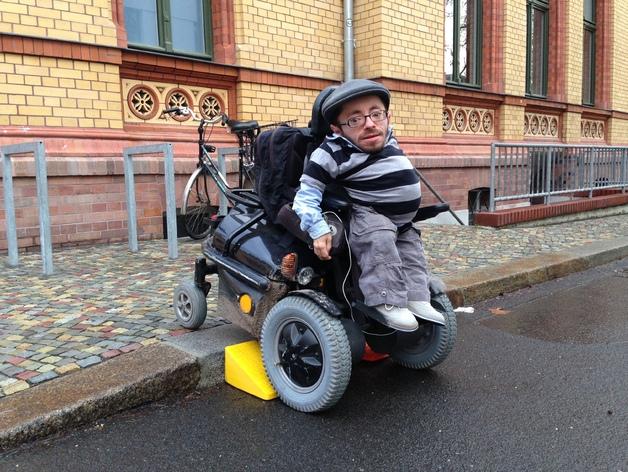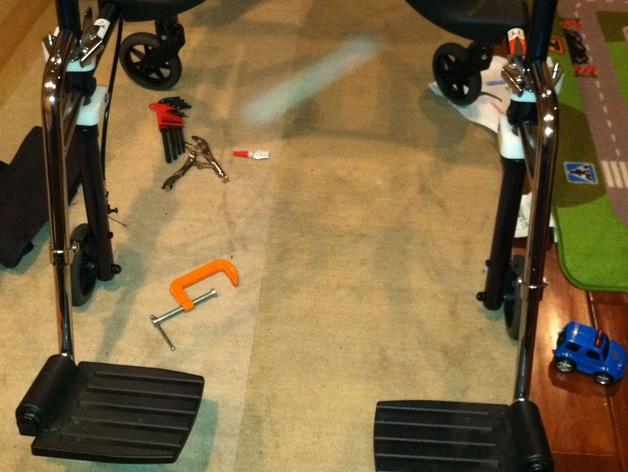With 3D Printing catching on so quickly all throughout the world, more and more people are getting creative with their ideas. Not only are designers coming up with ideas that are cool, interesting and breathtaking, but they are also designing objects that can help make a real difference in people’s lives.
Some designers are using their design skills and talent to try and help the handicapped. We’ve seen a dad that made a prosthetic hand for his son. We’ve also seen how $100 3D-printed arms have given Sudan war amputees a reason for hope. These are the stories that make the national news. However, there are a lot more people out there doing good for people in need, that are not recognized by the national media.
One example is by a designer named Raul Krauthausen, who would not consider himself a designer by any account. He has developed a 3D printed wheelchair ramp that allows his wheelchair to conquer the one step leading from the street to the sidewalk in front of a building. It’s quite a simple concept, that he has uploaded to Thingiverse, but one that makes getting around quite a bit easier.
We asked Mr. Krauthausen what gave him the idea for such a design. His answer will surprise you.
“I just started experimenting with 3D-design and I failed early,” he explained. “The first shape I got, was a triangle. I then thought, ‘hey, that looks like a ramp for my wheelchair,’ so I started to print it.”
Krauthausen has had the opportunity to use his ramp on many occasions. “It works well,” he explained. “But you really have to be a pro-driver because the ramps are very narrow and you need good skills.”
Krauthausen owns a MakerBot Replicator 2 printer, that can print using different types of plastic material called filament. As far as what his take is on the future of 3D printing, he doesn’t seem to be as big of a fan as a lot of us.
“I believe it is a bit overrated and overhyped. It won’t save the world or revolutionize capitalism. Having a printer doesn’t necessarily mean that you have good ideas or designing skills. I mean, look at me. I’m a lousy designer and I don’t want to become a good one. I’m too lazy.”
He has since rethought his idea for the ramp, and has developed a similar project using LEGOs, as seen in the video below:
Krauthausen isn’t the only person that is using the technology of 3D printing to design devices to help the handicapped.
Dave Matsumoto, another Thingiverse user, has created a wheelchair footrest adapter for a walker, to help his uncle move around better. The device took Matsumoto 7 revisions before he got it working just the way he wanted it to.
His idea came about, because his uncle has seizures on a regular basis. When this occurs, his mobility is impaired significantly. He loses control of his legs, thus it becomes very difficult for anyone to move him around, while he is using his walker. Matsumoto’s aunt asked him if it would be possible to put footrests like those found on a wheelchair on the walker. By doing this, he could get off of his feet, and allow his wife to push him as needed. So Matsumoto set out on a quest to make the idea a reality.
Matsumoto is more of a fan of 3D printing than Krauthausen is.
“I would never have been able to put something together for my uncle in a cost-effective way without it,” said Matsumoto. “I was going to weld metal brackets to his walker, but that would be way too permanent and I’d probably only get one shot at making it right.”
While, the design probably won’t be helping too many people, since it is a very specialized and specific device, it remains a perfect example of just how 3D printing is allowing people to manufacture a single item with multiple iterations. At the same time, the cost effectiveness of 3D printing far surpasses that of traditional manufacturing.
These are just a couple ways designers have taken to Thingiverse to develop devices for handicapped individuals. There are others, including the monogramemd wheelchair joystick handle, the wheelchair cup holder, and many many more.
Whether you support 3D printing as a technology or not, there is no denying that it is making a difference. Discuss this article, and other cool ideas you’ve seen utilized in 3D printing at: https://3dprintboard.com/showthread.php?1606-3D-Printing-and-the-way-it-is-benefiting-the-handicapped
Subscribe to Our Email Newsletter
Stay up-to-date on all the latest news from the 3D printing industry and receive information and offers from third party vendors.
You May Also Like
Profiling a Construction 3D Printing Pioneer: US Army Corps of Engineers’ Megan Kreiger
The world of construction 3D printing is still so new that the true experts can probably be counted on two hands. Among them is Megan Kreiger, Portfolio Manager of Additive...
US Army Corps of Engineers Taps Lincoln Electric & Eaton for Largest 3D Printed US Civil Works Part
The Soo Locks sit on the US-Canadian border, enabling maritime travel between Lake Superior and Lake Huron, from which ships can reach the rest of the Great Lakes. Crafts carrying...
Construction 3D Printing CEO Reflects on Being Female in Construction
Natalie Wadley, CEO of ChangeMaker3D, could hear the words of her daughter sitting next to her resounding in her head. “Mum, MUM, you’ve won!” Wadley had just won the prestigious...
1Print to Commercialize 3D Printed Coastal Resilience Solutions
1Print, a company that specializes in deploying additive construction (AC) for infrastructure projects, has entered an agreement with the University of Miami (UM) to accelerate commercialization of the SEAHIVE shoreline...
































